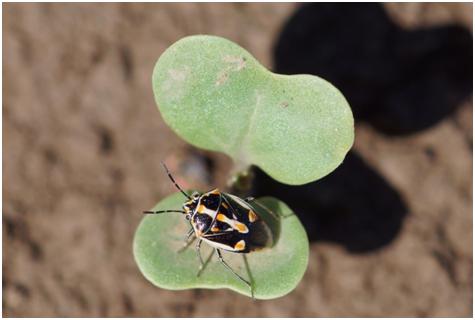 |
|
|
|

|
|||
| |
|||
Over the past several days Bagrada bugs populations have exploded throughout the desert. We first started to observe light to moderate populations in early September on broccoli destined for research trials here at the Yuma Ag Center. Because we wanted to conduct Bagrada efficacy trials, we did not chemigate our first 2 acre block (Aug 29 wet date). Within a week, we had lost about 75% of the stand to Bagrada and Flea beetle. Since then, we have planted several more blocks of broccoli with the same intention for research trails. But just this week the numbers increased significantly almost overnight and we've had to treat our broccoli just to maintain our stands for future Bagrada research. Based on my observations and research trials to date, the populations we're seeing here at YAC are much high than what we saw last year, and at this time more extreme than what we saw in 2010. I've had numerous reports this week of heavy populations occurring from Texas Hill, Tacna, Roll, Wellton, Dome Valley , Gila Valley and the Yuma Valley. Just about everwhere we grow produce, and I'm told it's just as bad in Imperial Valley. And it's early in the fall season. Why are Bagrada so abundant this year? I can't say, but my observations have been that they do real well under these hot growing conditions. A few things to remember: newly emerging stands are very susceptible to Bagrada feeding, particularly with the numbers that we're presently seeing. In the past 2 days I've observed wilted and dead seedlings in broccoli only 2 days post-emergence. Many of the other seedlings had feeding signs on the cotyledons. If possible, consider applying pyrethroids on these new stands with aerial applications rather than by chemigation. Your knockdown should be better, and residual will depend on sprinkler irrigation schedules. Also, they appear to be most active in the middle of the day, where they can be quite mobile (both walking and flying). But I've also been able to find them in the mornings (7:00 am) by carefully inspecting under the cotyledons, particularly if it appears to be fed on. The adult itself is actually smaller than a 5-6 day old cotyledon (see below) - so look carefully. Also, wet soil and sprinklers do not appear to deter the bug from infesting fields. As I've reported before, insecticides with contact activity appear to provide the most reliable control (i.e., pyrethroids, methomyl, chlorpyrifos). We’re conducting a number of efficacy trials right now, so if you want an update on what appears to be working just give us a call. I've attached another copy of our Bagrada Bug Management Tips for the Low Desert that may assist you in your battles against this invasive pest.
Remember: When in Doubt-Scout. Click picture to listen to John To contact John Palumbo go to: jpalumbo@ag.arizona.edu
|
|||
| Back | |||
For questions or comments on any of the topics please contact Marco Pena at the Yuma Agricultural Center. |
|||
| Home | Cotton
| Veggies | Forages
| Grains | Citrus
| Crop x Crop Insects | Diseases| Weeds | Pesticides | Economics | News | Weather | Research | Photos | Contacts | General Info. Copyright © 2001 University of Arizona, College of Agriculture and Life Sciences Webmaster: Al Fournier (acis@ag.arizona.edu) |
|||

